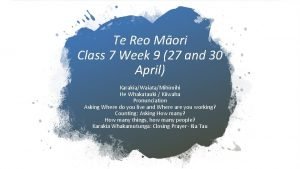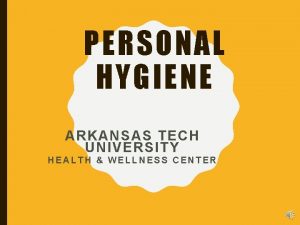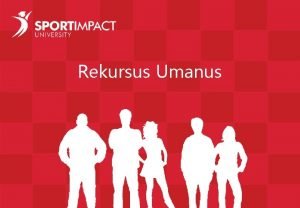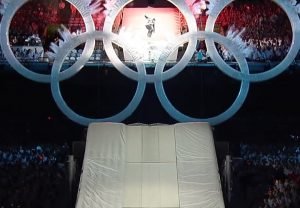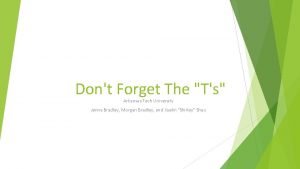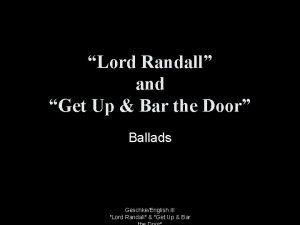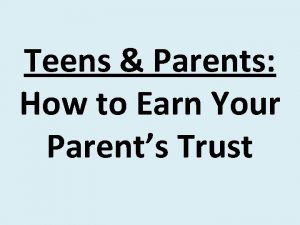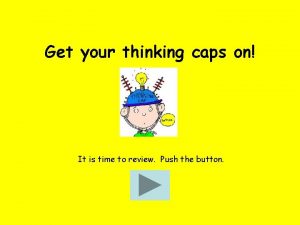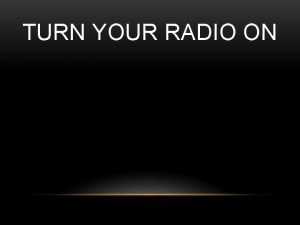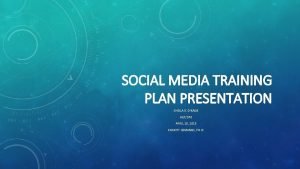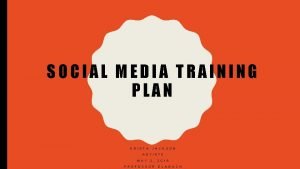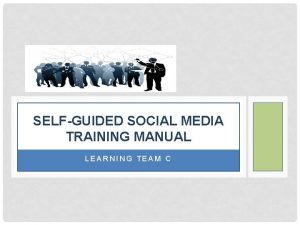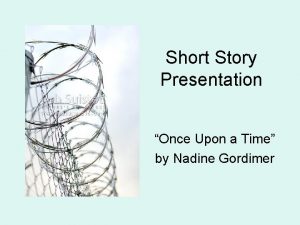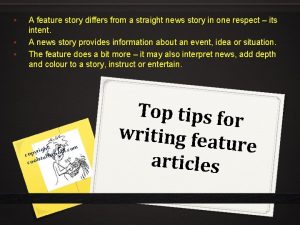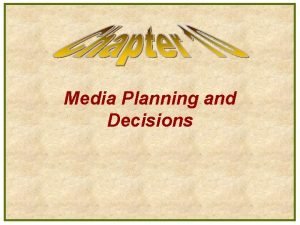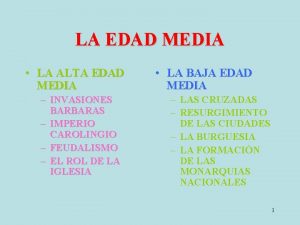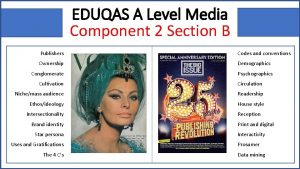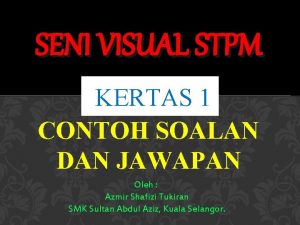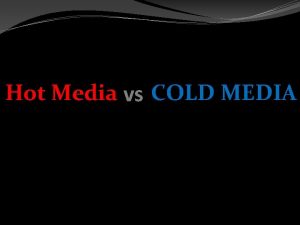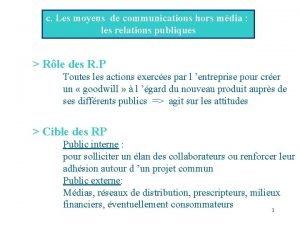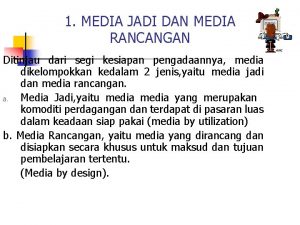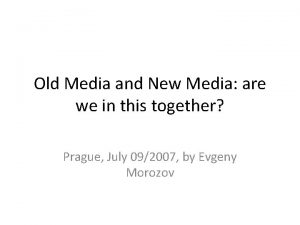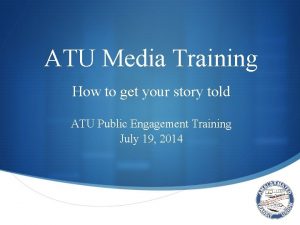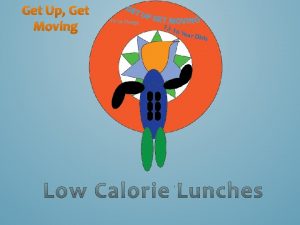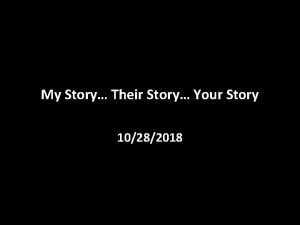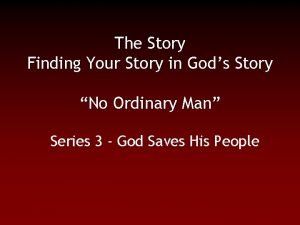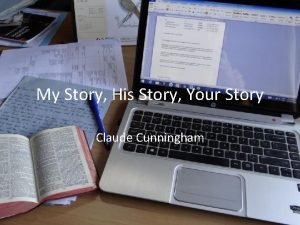ATU Media Training How to get your story

























































- Slides: 57

ATU Media Training How to get your story told ATU Public Engagement Training July 19, 2014 S

Learning Objectives • Why reach out to the media? • How to prepare for a media interview – dos and don'ts • Identifying and capitalizing on media opportunities • How to respond to tough questions • Practice by drafting press release, taped mock interviews, and actual podcast interviews.

Media Stories The Good, the Bad and the Ugly

Why Reach Out to the Media? • News media is not enemy and can be used effectively to get our messages out • Media will cover ATU stories • • • Strikes/Contract negotiations Transit cuts Charitable activities Assaults on transit workers ATU heroes

Why Reach Out to the Media? (cont. . ) • Tell and position our story • Shape opinions and attitudes (public) • Motivate audiences i. e. riders, the public and politicians – get people talking and doing

News Decision Makers Criteria S Ask yourself the following questions to determine if your story meets the news criteria: • • Is the information new? Is it timely? How widely known are the people involved? Is the source of the information credible? Does the information affect the news outlet’s audience? How close to home is the story for the outlet’s audience? Is the message/argument addressed in the story persuasive?

News Decision Makers Criteria (cont. . ) • • • Is there a built-in conflict? Is there anything about the story that makes it unusual or off the beaten path? Is there human interest in the story? Is there an inherent emotional response to the story that will move the audience? Is there a universal truth expressed in the story with which people would identify?

Media Opportunity Examples • When public debate or controversy around an issue is aroused • When the opposition actively calls for action against you • When your issue is being covered by the media • When hearings are held on the issue • When a legislative body debates your issue or something related to your issue • When plans for implementation are developed • When the opposition is seeking funding for competing

Types of Media Relations IN-ACTIVE RE-ACTIVE PRO-ACTIVE Spectator Sidelines Non-player Responding Can be negative Can be defensive Positive Agenda setting Takes offensive

Key Steps to Prepare • Preparation • Executing • Feedback • Evaluation • Modification

Three C’s of Working with Media • Control the interview • Cooperate • Communicate

Understanding the Media PRINT More in-depth Specialized Flexibility Facebook Less visual Know your stuff BROADCAST Immediacy Visual Tighter deadlines INTERNET Websites You. Tube Style over substance Bloggers Twitter However, all media now use multiple outlets (website, Facebook, Twitter, video) to push out news.

Who are your key audiences? S INTERNAL S EXTERNAL S Members S Riders S Management team S Policy Makers S Leadership team S Media S General Public

Media as Audience S In most cases, the media is a conveyor of your message, not your primary audience. S Target media that your primary audience rely upon for information.

When to Craft Media Messages S To impart information. S Build awareness. S To motivate people to act. S To generate affinity. S To defend your position.

What is a Message? Information News Intelligence Advice Directions Request A Moral Point Source: Webster’s Dictionary

Developing Our Message • Real people/protecting our profession • Relating to the riders/public • Clear, concise, and simple • Frame our messages to appeal to target audience • • Riders Non-riders/Public Members Public officials

Developing Our Message (cont. . ) • Use everyday language, avoid jargon • Appeal to people’s values and emotions • Personal experience/humanize message/use workers • Consistent messages

Which message appeals to public? “Slashing bus service and laying off bus drivers is not the right way to balance the city budget. Our members have sacrificed enough. ” Or “The public deserves reliable, affordable public transportation that can get them safely to and from work, school, and other daily tasks. Cutbacks to bus service will hurt our community in this times of economic recovery. ”

A Few Key ATU Messages • Public transportation benefits society • • Service cuts impact the local economy • • Robust public transit plays a key role in creating stronger, cleaner, healthier, mobile and vibrant communities. Public transportation takes workers to their jobs and brings customers to businesses’ doors. In a time of economic recovery, we need to make sure this vital economic circulation is taking place. Transportation is about equity • Everyone – the elderly, disadvantaged, disabled, and minorities deserve equal, accessible, reliable public transportation that will get them safely to and from school, the doctors and other daily tasks.

How to Craft Messages S What is the issue/problem? S What are the relevant facts/findings and do they constitute new information? S Is there a remedy? S Who is/are the audience(s)?

When to Craft Media Messages S When your research uncovers new information/data (proactive). S When your research reveals a new way of looking at or solving old problems (proactive). S When an adversary asserts a message that your work contradicts (reactive).

Message Development Process Issue Fact Message Remedy

How to Identify and Seize News Opportunities S

Opportunities Emerge When… S Your issue appears in the news; S The opposition calls for actions that contradict your position; S Editorial writers/columnists address your issue; S Legislators debate your issue; S Plans for policy implementation develop; and S The opposition seeks funding or public support for

Tools of Media Relations S Press Kit S News Release/Advisory S Press Conference/Briefing S The Media Interview S A Media-Friendly Web Site

Press Kit S Bio S Photo S Backgrounder S Fact Sheet S Relevant News Clippings S Press Release

A Good Press Release S Release date. S Contact name and phone number. S Headline asserting key message S Subhead that asserts secondary message (optional). S Lead graph that answers the 4 Ws S Guidance about where to go for more information.

Media-Friendly Web Sites S Have complete contact information. S Include titles and abstracts of major reports. S Include bio. S Include a few news clippings. S Are easy to navigate. S Can be found using keywords on major search engines.

Proactive v. Reactive Strategy PROACTIVE S Initiating media contact (phone calls op-eds, letters, etc. ) S Keeping key reporters informed. S Issuing news releases S Holding press. conferences/briefings. REACTIVE S Letters to the Editor S Initiating Reactive Media Calls S Reactive Interviews S Op-ed Pieces

Proactive Tactics S The pitch letters/calls S Op-eds S Emails, letters, and faxes S News releases S Newsletters (electronic and print) S Press conferences/briefings

The Pitch Letter or Call S Explain who you are, your expertise, where you’re from. S Point out the newsworthiness of what you’re pitching. S Tie the story to their readers. S Explain how it relates to other stories that they’ve run or that are in the news. S Tell how and when you can be reached.

When to do Press Conferences S When you have breaking information that can’t be released as effectively otherwise; S When your message is controversial; S When your issue has broad appeal; S When you have highly visible or controversial spokespersons; and S When you have visuals that make good television or photos.

Making the Most of a Press Conference S Open with key message. S Outline details of announcement and sub- messages. S Involve and identify key personalities/players. S Close by repeating key message. S Offer either people or visuals to increase likelihood of coverage.

Reactive Tactics S Writing letters to editor/ op-ed pieces S Initiating reactive media calls. S Responding effectively when a reporter calls.

Letters to the Editor S No more than 3 -5 short paragraphs or 150 -200 words. S Identify triggering story in first graph, including headline and when it ran. S Make key point in first or second draft. S Back up position in remaining graph(s)

The Effective Op-Ed S Features attention-grabbing headline. S Identifies topic in the first graph. S Uses facts to underscore main point. S Uses the narrative voice. S Runs between 600 -800 words. S Submitted with cover letter that identifies writer as an credible authority on subject.

Initiating Reactive Contact On the Phone Via Email, Fax, Twitter S Explain why you’re S Call only if you have a S Limit yourself to 200 S Be sensitive to deadlines. S Identify when you’re calling. substantive addition. S Follow-up with written information. writing in the first graph. words or less. available to talk via phone or in person.

Responding to Media Calls S If you’re not prepared, politely explain that you’re busy and find out when you can call back within their deadline. S If the question is out of your area, bring them back to your field of expertise. S Don’t be afraid to rephrase questions. S Be succinct.

Things to Remember S Respect deadlines. S Stay on message. S Be succinct. S Tell the truth. S Don’t be a pest.

Tips to Prepare for Media Interviews • Avoid “inside speak” & jargon – explaining to a 7 year-old • Speak slowly and clearly • Be prepared • Practice, practice • Emphasize 3 -4 main points • Have sound bites ready (reporters want 7 -10 seconds max)

Tips to Prepare for Media Interviews (cont. ) • Be confident, relaxed, and enthusiastic • Listen to the questions and take as long as you need to answer – exception Live TV • Include question in answer (avoid “it”) • Don’t say “as I said” or “you know” • Try to keep ‘ums” to a minimum • Just facts: don’t fill empty space

Tips to Prepare for Media Interviews (cont. ) • Interviews are like business transactions • Stop talking when your point has been made • If you don’t know an answer, it’s ok, say you’ll find out • Smile, don’t be afraid to appear friendly. It makes you real • Remember you are the Expert!

Tips to Prepare for Media Interviews (cont. ) S Be Friendly and Honest • Never lie • If you don’t know the answer, say you don’t, but you’ll find out and get back to the reporter as soon as possible Never respond with no comment, it sounds like you have something to hide Instead, explain why you can’t answer and go back to your main points • •

Tips to Prepare for Media Interviews (cont. ) S Don’t Lose Your Cool • • Some reporters like to bait interviews or play devil’s advocate Don’t give angry or defensive responses, simply redirect your answer to your main points S Don’t Over Prepare • • If it sounds like you memorized a speech or your mannerisms look rehearsed, your message loses much of its effectiveness RELAX!

Avoid Interview Pitfalls • Take control • Anticipate tough questions • Do not repeat a negative • Stay calm • If you don’t want a statement quoted, don’t say it

Avoid Interview Pitfalls (cont. ) • You don’t have to answer a question even if the reporter asks numerous times • Silence does not mean you need to talk • Remember you are always “on the record”. Be mindful what you say.

Tricks of the Trade • Flagging (emphasizing) • Bridging (transition) • Hooking (leading)

Some Examples • Hooking – “But that’s not the most important issue” • Flagging • “The bottom line is…” • “The key to remember here is…” • Bridging • “I can’t speculate on that, but what I can tell you is…” • “On the contrary…”

Tips for TV Interviews • Know the technology • Format • Live or taped • Re-taping answers • Sounds bites • Camera angles (look at reporter not camera) • Gestures

Common Interview Mistakes S Assuming reporter is S Asking to see story before S Failing to return reporter S Calling to complain after S Lack of preparation. S For broadcast: using the familiar with the topic. calls in a timely manner. it runs. the story runs. word uh, repeatedly.

Common TV Mistakes S Looking directly into the camera instead of at the interviewer. S Using distracting gestures. S Speaking in a muffled voice. S Coughing, sneezing, blowing nose. S Holding up props to the camera. S Wearing distracting clothing.

Be Prepared S It helps to have a folder handy with the following: S Your core message S Main data/findings S News clippings on the topic S Fact sheets S Other press kit components

Anatomy of a TV News Story • 7 -10 seconds – Anchor • 7 -10 seconds – Reporter on scene • 7 -10 seconds – Background • 7 -10 seconds – Expert (you) • 7 -10 seconds – Reporter • 7 -10 seconds – Anchor • Total – 50 -70 seconds

TV Dress Guidelines • Wear ATU shirt, ATU union pin or uniform • Wear solid colors – neutral or dark blue • Avoid stripes and complex patterns • Avoid flashy jewelry (dangling earrings, necklaces, bracelets)

Tips for Radio Interviews • Live or taped • Debates or call-in shows • Repeat major points • Vary the speed and pitch of your voice

Tips for Print Interviews • If you are unsure of the exact answer or data, it is ok to get back to reporter • Offer charts/tables/photos if available • Offer background when possible • Sounds bites, your quote will be very short
 Get into get out of
Get into get out of One thing by one direction figurative language answers
One thing by one direction figurative language answers Aroha mai, aroha atu whakatauki
Aroha mai, aroha atu whakatauki Rtd/atu 1001 pension plan
Rtd/atu 1001 pension plan Definisaun lideransa
Definisaun lideransa Atu health and wellness
Atu health and wellness Presiza
Presiza Saida mak desportu
Saida mak desportu Organigrama atu
Organigrama atu Atu residence halls
Atu residence halls Get up get moving quiz
Get up get moving quiz Get up get moving quiz
Get up get moving quiz Get up get moving quiz
Get up get moving quiz Pseudocode repetition
Pseudocode repetition Get focused get results
Get focused get results Get up get moving quiz
Get up get moving quiz Give us your hungry your tired your poor
Give us your hungry your tired your poor Theme of get up and bar the door
Theme of get up and bar the door Blessing a taonga karakia
Blessing a taonga karakia Get to know your friends questions
Get to know your friends questions Shivaji university get your password
Shivaji university get your password How to regain your parents trust
How to regain your parents trust Cvpr buzz
Cvpr buzz Get your thinking caps on
Get your thinking caps on Somebody once asked could i spare some change for gas
Somebody once asked could i spare some change for gas Confirm your email now and get 5 minutes as a gift!
Confirm your email now and get 5 minutes as a gift! Turn on your radio
Turn on your radio Yidarton.net/to get your prize
Yidarton.net/to get your prize Get your mind right meaning
Get your mind right meaning Training is expensive without training it is more expensive
Training is expensive without training it is more expensive Perbedaan on the job training dan off the job training
Perbedaan on the job training dan off the job training Aggression replacement training facilitator training
Aggression replacement training facilitator training Social media training presentation
Social media training presentation Conclusion of social media
Conclusion of social media Social media training manual
Social media training manual Once upon time story short
Once upon time story short Short paragraph to entertain
Short paragraph to entertain Short story meaning
Short story meaning Straight news story
Straight news story Every picture has a story and every story has a moment
Every picture has a story and every story has a moment Stories
Stories Difference between differential and selective media
Difference between differential and selective media Contoh media jadi
Contoh media jadi Major advertising decisions
Major advertising decisions Example
Example Alta edad media y baja edad media
Alta edad media y baja edad media Cuadro comparativo de la alta y baja edad media
Cuadro comparativo de la alta y baja edad media Hot and cold medium
Hot and cold medium Fastidious bacteria
Fastidious bacteria A level media component 2
A level media component 2 Ciri ciri seni tradisi stpm
Ciri ciri seni tradisi stpm Hot media and cold media
Hot media and cold media Moyens de communication hors média
Moyens de communication hors média Wired and wireless media
Wired and wireless media Media jadi dan media rancangan
Media jadi dan media rancangan Hot cold media
Hot cold media New media vs old media
New media vs old media Betty chiang
Betty chiang


